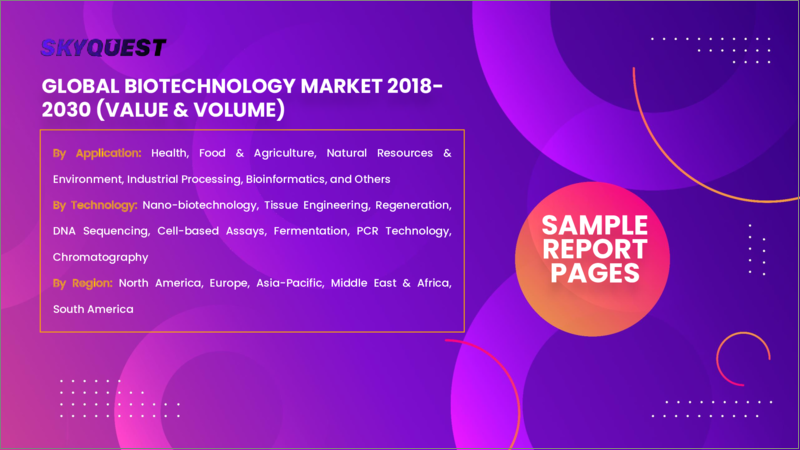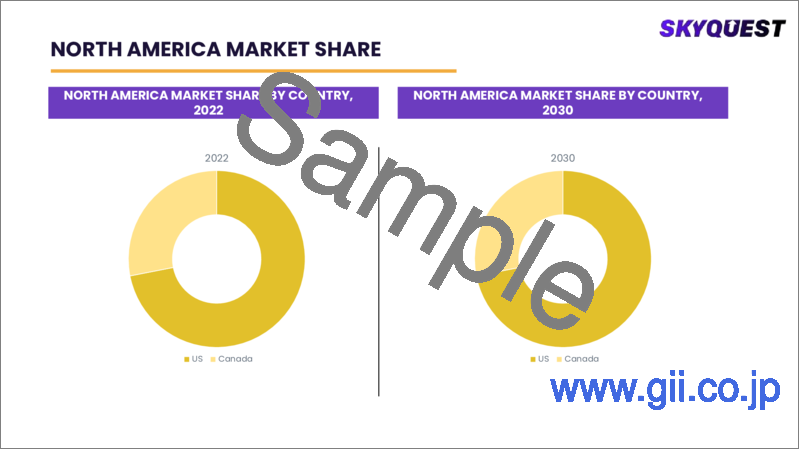|
|
市場調査レポート
商品コード
1286049
バイオテクノロジーの世界市場の規模、シェア、成長分析:技術別、用途別 - 産業予測(2023年~2030年)Global Biotechnology Market Size, Share, Growth Analysis, By Technology(Nano-biotechnology, Tissue Engineering), By Application(Health, Food & Agriculture) - Industry Forecast 2023-2030 |
||||||
| バイオテクノロジーの世界市場の規模、シェア、成長分析:技術別、用途別 - 産業予測(2023年~2030年) |
|
出版日: 2023年04月30日
発行: SkyQuest
ページ情報: 英文 157 Pages
納期: 3~5営業日
|
- 全表示
- 概要
- 目次
世界のバイオテクノロジーの市場規模は、2022年の1兆2,024億4,000万米ドルから2030年までに3兆8,795億1,000万米ドルに達し、予測期間(2023年~2030年)にCAGRで13.9%の成長が予測されています。製薬業界における、強力な医薬品に用いる医薬品有効成分(API)の生成に向けた中間体を合成するための酵素の需要が、市場の成長を促進する見込みです。
当レポートでは、世界のバイオテクノロジー市場について調査分析し、市場力学と見通し、セグメント分析、企業プロファイルなどを提供しています。
目次
エグゼクティブサマリー
調査手法
親市場の分析
主な市場の考察
- 技術分析
- 価格分析
- サプライチェーン分析
- バリューチェーン分析
- 市場のエコシステム
- IP分析
- 貿易分析
- スタートアップ分析
- 原材料の分析
- イノベーションマトリックス
- パイプライン製品の分析
- マクロ経済指標
- 主な投資の分析
- 主な成功要因
- 競合の程度
市場力学と見通し
- 市場力学
- 促進要因
- 機会
- 抑制要因
- 課題
- 規制情勢
- ポーターのファイブフォース分析
- 将来の混乱についての特別な考察
世界のバイオテクノロジー市場:技術別
- 市場の概要
- ナノバイオテクノロジー
- 組織工学
- 再生
- DNAシーケンシング
- セルベースアッセイ
- 発酵
- PCR技術
- クロマトグラフィ
世界のバイオテクノロジー市場:用途別
- 市場の概要
- 健康
- 食品・農業
- 天然資源・環境
- 工業加工
- バイオインフォマティクス
- その他
世界のバイオテクノロジーの市場規模:地域別
- 市場の概要
- 北米
- 米国
- カナダ
- 欧州
- ドイツ
- スペイン
- フランス
- 英国
- その他の欧州
- アジア太平洋
- 中国
- インド
- 日本
- 韓国
- その他のアジア太平洋
- ラテンアメリカ
- ブラジル
- その他のラテンアメリカ
- 中東・アフリカ
- GCC諸国
- 南アフリカ
- その他の中東・アフリカ
競合情勢
- 上位5社の比較
- 主要企業の市場ポジショニング(2021年)
- 主な市場企業が採用した戦略
- 主な成功戦略
- 市場における最近の活動
- 主要企業の市場シェア(2021年)
主要企業プロファイル
- AstraZeneca
- Gilead Sciences, Inc.
- Bristol-Myers Squibb
- Amgen Inc.
- Biogen Inc.
- Celgene Corporation (now part of Bristol Myers Squibb)
- Illumina, Inc.
- Novo Nordisk A/S
- Thermo Fisher Scientific Inc.
- AbbVie Inc.
- Regeneron Pharmaceuticals, Inc.
- Vertex Pharmaceuticals Incorporated
- Roche Holding AG
- Genentech, Inc. (a subsidiary of Roche Holding AG)
- Moderna, Inc.
- Bio-Rad Laboratories, Inc.
- Qiagen N.V.
- Agilent Technologies, Inc.
- Lonza Group AG
- Pfizer Inc.
Biotechnology Market size was valued at USD 1055.7 billion in 2021 and is poised to grow from USD 1202.44 billion in 2022 to USD 3879.51 billion by 2030, growing at a CAGR of 13.9% in the forecast period (2023-2030).
Utilising living objects, biological systems, or their derivatives to change or develop production processes and therapies, biotechnology is an interdisciplinary, cutting-edge discipline. It has a substantial impact on a number of industries, including food and chemical production, medicine and pharmaceuticals, genetics, and others. In tackling urgent challenges connected to environmental protection, food and energy security, and health and welfare, it plays a vital and comprehensive role. The primary drivers of the biotechnology industry are the regulatory support provided by governments of various countries, increased food demand, technical improvements to combat serious diseases, and the depletion of natural resources. However, a number of issues, such as the lengthy period it takes for research to be commercialised and societal perceptions about biotech products, are limiting the growth of the biotechnology business. Nanotechnology, cloning, and stem cell research are some of the swiftly evolving biotechnology technologies of the present.
Due to the expansion of the biotechnology industry in developing countries like China, Japan, and India, the market is being driven by advantageous government initiatives. The government authority is working to simplify the administrative process for medications, improve repayment schemes, help the item endorsement process, and streamline the clinical research process. The organisation will have a solid basis for future growth thanks to all of these measures. The lengthy lab-to-market period is one of the major market hurdles for biopharmaceutical drugs. Before a drug can be offered on the open market, it must undergo a 12- to 15-year development period. Social and ethical issues surrounding clinical trials are another hindrance to the development of the biotechnology industry.
Top-down and bottom-up approaches were used to estimate and validate the size of the Global Biotechnology Market and to estimate the size of various other dependent submarkets. The research methodology used to estimate the market size includes the following details: The key players in the market were identified through secondary research, and their market shares in the respective regions were determined through primary and secondary research. This entire procedure includes the study of the annual and financial reports of the top market players and extensive interviews for key insights from industry leaders such as CEOs, VPs, directors, and marketing executives. All percentage shares split, and breakdowns were determined by using secondary sources and verified through Primary sources. All possible parameters that affect the markets covered in this research study have been accounted for, viewed in extensive detail, verified through primary research, and analyzed to get the final quantitative and qualitative data.
Segments covered in this report:
Global biotechnology market is segmented based on the Technology type, end use and region. Based on Technology the Global biotechnology market is segmented into Nano-biotechnology, Tissue Engineering and Regeneration, DNA Sequencing, Cell-based Assays, Fermentation, PCR Technology, and Chromatography. Based on Application, the market is segmented into Health, Food & Agriculture, Natural Resources & Environment, Industrial Processing, Bioinformatics, and Others. Based on Region it is categorized into North America, Europe, Asia-Pacific, Latin America, and MEA.
Driver
It is thought that the prevalence of chronic diseases is rising. Chronic illnesses are more prevalent than ever. People are growing more sedentary as the middle class expands and urbanisation picks up speed. Genetic anomalies, diabetes, malaria, HIV, and other illnesses including TB and obesity are on the rise as a result. An increase in the prevalence of target diseases and genetic anomalies, ongoing technological breakthroughs in Polymerase Chain Reaction technologies, and an increase in investments, finance, and grants for scientific research are further factors influencing market revenue growth. The biopharmaceutical industry helps to ward off chronic illnesses. The biopharmaceutical industry is concentrating on developing customised treatments. As a result, individualised procedural healthcare standards will be developed and some hereditary genetic disorders will be treated.
The demand for enzymes in the pharmaceutical sector to synthesise intermediates for the creation of active pharmaceutical ingredients (API) for potent medicines is anticipated to drive market growth. The ability of an enzyme to convert complicated molecules into more basic ones (converting starch to glucose in the food and beverage industry), the elimination of fat and oil stains in the detergent industry, the production of bioethanol for use in biofuels, and improved bleaching properties in the paper and pulp industries are the factors anticipated to drive the demand for enzymes in the upcoming years.
Restraint
Medical biotechnology's consequences pose a severe threat to clinical trials. The testing of the technology has led to injuries and occasionally fatalities because it is so new. These hazards should be carefully considered before using technology on humans, and anyone participating in a trial should be well-informed of the potential repercussions. People who are ill sometimes experiment with new things in the vain hope of getting better, which is a paradox. This shows that scientists and medical professionals have a serious ethical responsibility to fully inform patients of the risks and respect their final decision.
Market Trends
Expanding discoveries in the life sciences are offering important benefits for healthcare interventions and productivity by combining cutting-edge technologies. The development of novel techniques and their corporate acceptance have a positive effect on the biotech sector and are anticipated to significantly increase market growth. Modern technology are being used in medicine, such as 3D bioprinting. A few body parts that can be created utilising 3D bioprinting and living cells include skin, cartilage, and heart valves. The potential for developing drugs, tissues, and organs like the liver and heart using patient body cells is enormous. Accurate models for study and analysis will be made available, broadening the range of applications for human cells and tissues in medical research.
Another cutting-edge tool for monitoring a person's health that has been introduced as a result of advancements in medical technology is biosensors. Biosensors are used to keep track of a variety of biosignatures, including the heartbeat, blood pressure, body temperature, and others. With the use of this technology, medical practitioners may more easily monitor patients from a distance while also receiving crucial health data.
Table of Contents
Executive Summary
- Market Overview
- Wheel of Fortune
- Research Methodology
- Information Procurement
- Secondary & Primary Data Sources
- Market Size Estimation
- Market Assumptions & Limitations
Parent Market Analysis
- Market Overview
- Market Size
- Market Dynamics
- Drivers
- Opportunities
- Restraints
- Challenges
- Key Market Insights
- Technology Analysis
- Pricing Analysis
- Supply Chain Analysis
- Value Chain Analysis
- Ecosystem of the Market
- IP Analysis
- Trade Analysis
- Startup Analysis
- Raw Material Analysis
- Innovation Matrix
- Pipeline Product Analysis
- Macroeconomic Indicators
- Top Investment Analysis
- Key Success Factor
- Degree of Competition
- Market Dynamics & Outlook
- Market Dynamics
- Drivers
- Opportunities
- Restraints
- Challenges
- Regulatory Landscape
- Porters Analysis
- Competitive rivalry
- Threat of Substitute Products
- Bargaining Power of Buyers
- Threat of New Entrants
- Bargaining Power of Suppliers
- Skyquest Special Insights on Future Disruptions
- Political Impact
- Economic Impact
- Social Impact
- Technical Impact
- Environmental Impact
- Legal Impact
- Global Biotechnology Market by Technology
- Market Overview
- Nano-biotechnology
- Tissue Engineering
- Regeneration
- DNA Sequencing
- Cell-based Assays
- Fermentation
- PCR Technology
- Chromatography
Global Biotechnology Market by Application
- Market Overview
- Health
- Food & Agriculture
- Natural Resources & Environment
- Industrial Processing
- Bioinformatics
- Others
- Global Biotechnology Market Size by Region
- Market Overview
- North America
- USA
- Canada
- Europe
- Germany
- Spain
- France
- UK
- Rest of Europe
- Asia Pacific
- China
- India
- Japan
- South Korea
- Rest of Asia-Pacific
- Latin America
- Brazil
- Rest of Latin America
- Middle East & Africa (MEA)
- GCC Countries
- South Africa
- Rest of MEA
- Competitive Landscape
- Top 5 Player Comparison
- Market Positioning of Key Players, 2021
- Strategies Adopted by Key Market Players
- Top Winning Strategies
- By Development
- By Company
- By Year
- Recent Activities in the Market
- Key Companies Market Share (%), 2021
- Key Company Profiles
- AstraZeneca
- Company Overview
- Business Segment Overview
- Financial Updates
- Key Developments
- Gilead Sciences, Inc.
- Company Overview
- Business Segment Overview
- Financial Updates
- Key Developments
- Bristol-Myers Squibb
- Company Overview
- Business Segment Overview
- Financial Updates
- Key Developments
- Amgen Inc.
- Company Overview
- Business Segment Overview
- Financial Updates
- Key Developments
- Biogen Inc.
- Company Overview
- Business Segment Overview
- Financial Updates
- Key Developments
- Celgene Corporation (now part of Bristol Myers Squibb)
- Company Overview
- Business Segment Overview
- Financial Updates
- Key Developments
- Illumina, Inc.
- Company Overview
- Business Segment Overview
- Financial Updates
- Key Developments
- Novo Nordisk A/S
- Company Overview
- Business Segment Overview
- Financial Updates
- Key Developments
- Thermo Fisher Scientific Inc.
- Company Overview
- Business Segment Overview
- Financial Updates
- Key Developments
- AbbVie Inc.
- Company Overview
- Business Segment Overview
- Financial Updates
- Key Developments
- Regeneron Pharmaceuticals, Inc.
- Company Overview
- Business Segment Overview
- Financial Updates
- Key Developments
- Vertex Pharmaceuticals Incorporated
- Company Overview
- Business Segment Overview
- Financial Updates
- Key Developments
- Roche Holding AG
- Company Overview
- Business Segment Overview
- Financial Updates
- Key Developments
- Genentech, Inc. (a subsidiary of Roche Holding AG)
- Company Overview
- Business Segment Overview
- Financial Updates
- Key Developments
- Moderna, Inc.
- Company Overview
- Business Segment Overview
- Financial Updates
- Key Developments
- Bio-Rad Laboratories, Inc.
- Company Overview
- Business Segment Overview
- Financial Updates
- Key Developments
- Qiagen N.V.
- Company Overview
- Business Segment Overview
- Financial Updates
- Key Developments
- Agilent Technologies, Inc.
- Company Overview
- Business Segment Overview
- Financial Updates
- Key Developments
- Lonza Group AG
- Company Overview
- Business Segment Overview
- Financial Updates
- Key Developments
- Pfizer Inc.
- Company Overview
- Business Segment Overview
- Financial Updates
- Key Developments




